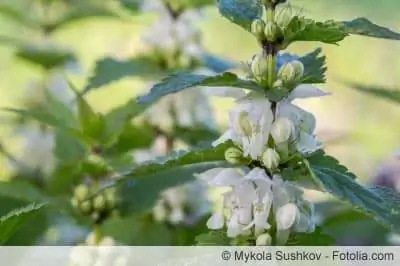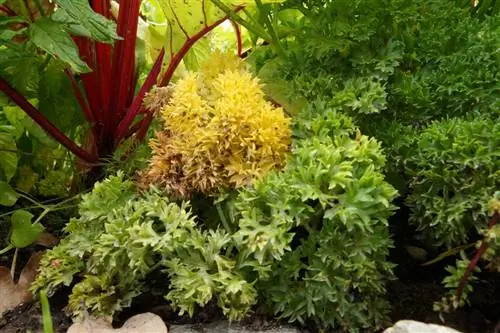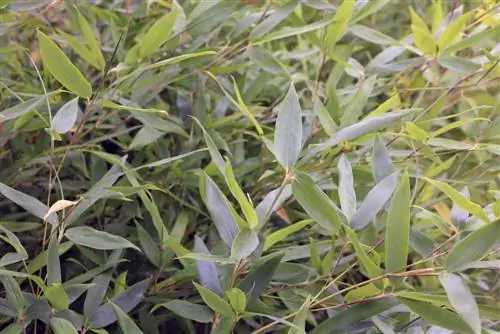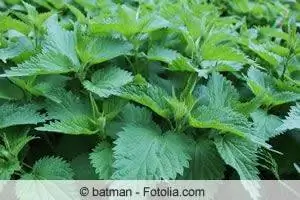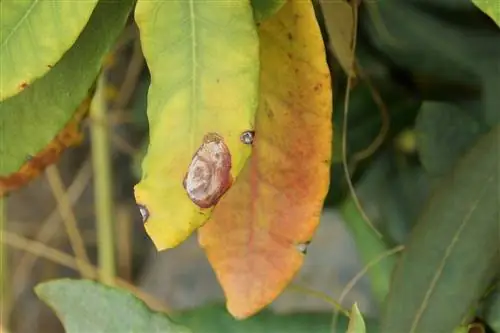- Author admin [email protected].
- Public 2023-12-17 03:39.
- Last modified 2025-06-01 06:48.
Deadnettle can be clearly recognized by the missing stinging hairs. The plants are ideal for natural gardens, but are otherwise often viewed as weeds and eliminated. This is doing them an injustice. They are easy-care plants that are ideal for larger areas because they spread themselves and form dense carpets. They still bloom beautifully and/or impress with interesting spotted or differently marked foliage. There are numerous species and varieties and some of them are really pretty. You should try these versatile plants.
Short profile of the deadnettle
- Genus Lamium
- Includes 25 to 30 species
- Lamiaceae family
- Annual to perennial herbaceous plants
- Hairy stems and leaves
- Flower calyx tube-shaped to bell-shaped
- Upper and lower lip
- Flowers white, pink, purple or yellow
- There are hermaphrodite but also purely female flowers
- Flowering time depending on the species from spring to autumn
- Partial fruits
- Bee pasture, very popular with numerous insects
Species
Deadnettle species are similar, but also have differences. The white deadnettle in particular is often confused with the stinging nettle, but this is mainly due to the white flowers that are unique to both plants. Otherwise, most species can be easily distinguished by different flower colors. Many species are considered weeds, only a few are specifically cultivated. The most popular is the spotted deadnettle.
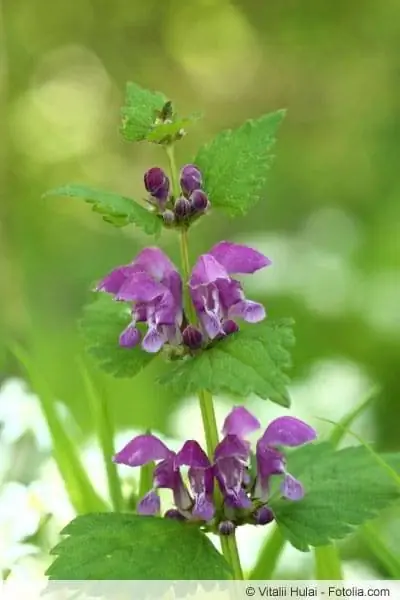
- White Deadnettle (Lamium album) - white flowers, very similar to stinging nettle, used in medicine, edible, 20 to 70 cm high, blooms from April to October
- Spotted deadnettle (Lamium maculatum) - various varieties, very beautiful leaves, silver-gray to white patterned, often variegated, flowers mostly purple, rarely white
- Giant deadnettle (Lamium orvala) - white-pink (sometimes crimson) flowers, ideal for partially shaded places, 40 to 100 cm high, does not form runners, has a rhizome, flowering from April to June
- Purple Deadnettle (Lamium purpureum) - purple flowers, 15 to 45 cm high, blooms April to October, young leaves tinged with purple
- Common golden nettle (Lamium galeobdolon) - small yellow flowers with delicate markings from April to June, 15 to 60 cm tall, green leaves, often with a whitish or silver ornament
- Mountain Golden Nettle (Lamium montanum) - yellow flowers, flower whorl of 5 to 8 flowers, runners are sterile and die in winter, therefore no spread
- Silvery-leaved deadnettle (Lamium argentatum) - many yellow flowers, silvery spotted foliage, similar to golden nettle
Deadnettle care
Caring for the deadnettle is incredibly easy. The location and substrate must be suitable. They also need water and nutrients. There's not much more to do, except to ensure that invasive species don't spread too far.
Site conditions
Deadnettles prefer partially shaded or even shady locations. They don't do well in the sun unless the water supply is good. But even then, morning and evening sun is recommended. The plants cannot tolerate bright midday sun. A place under trees with a trunk and enough space for the height growth of the nettle plants is ideal. In good places, dead nettles form dense ground coverings and are good ground cover. They are more foliage plants than flowering plants. They can also be combined well with other plants. Some species are even suitable for pot cultivation.
- Penumbra and shadow
- Morning and evening sun, no midday sun
A loose, permeable and humus-rich mixture is suitable as a plant substrate. The soil should be rich in nutrients and not too dry. A slightly moist substrate is better. But it shouldn't be too wet under any circumstances. Waterlogging must be prevented at all costs.
- Loose, humic, permeable
- Nutritious, slightly moist
Plants
The best time to plant dead nettles is in spring or fall. The plants look best in small groups, around 5 together. If you want to achieve a closed carpet, plant 8 to 15 plants per square meter, depending on how quickly the area needs to be closed. The planting distance should be at least 20 cm.
- Plants in spring or autumn
- 8 to 15 plants per m²
- Maintain planting distances
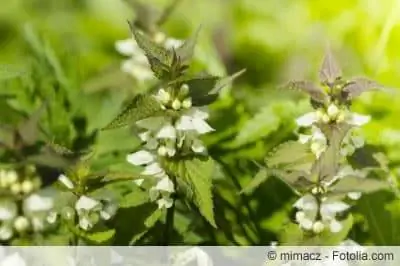
Watering and fertilizing
Lamium are quite undemanding. They should be watered regularly, but otherwise require very little care. The soil should not dry out. It is better if it is always a little moist. Especially when keeping containers, it is important that neither too much nor too little is watered. The top layer of substrate should dry out, but the entire soil should not dry out. Avoid standing water.
- Always keep the soil slightly moist
- Avoid constant wetness and dryness
Deadnettles thrive better when they have sufficient nutrients available. It is recommended to provide them with additional fertilizer every four weeks, but only in half the specified concentration.
- Fertilize every four weeks
- Only half concentration
cutting deadnettle
You don't have to cut the deadnettle much. Only the parts of the plant that have turned brown need to be removed. The nettle is evergreen, so it still looks nice even in winter. Therefore, the plants should not be cut back in autumn. The foliage also provides protection for the roots. It is enough to remove unsightly parts of the plant. Otherwise there is no need to cut. Instead of cutting dead nettles, you're more likely to have to work on containing the spread. In places where they like it, the plants tend to become a bit overgrown. That's why they should be stabbed specifically.
- Do not cut
- Only remove plant parts that have become unsightly
Overwintering deadnettle
Lamium are extremely hardy. They have no problems with high temperatures and do not need any additional protection. It is important to remember to water even in winter. Even in the cold season there can be long dry periods. On frost-free days it is therefore important to provide the plants with water.
- Very frost hardy
- Watering even in winter
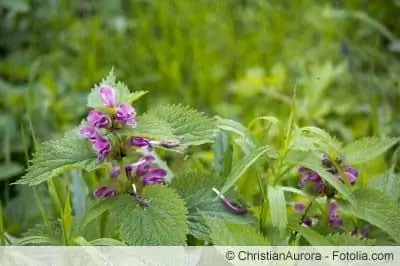
Tip:
Occasionally weeds should be removed between plants, at least from freshly planted stocks. Later these are so dense that weeds hardly have a chance.
Propagate
Deadnettle can be propagated by sowing, cuttings and division. However, the plants also like to spread independently, which is not always desirable. Dead nettles not only sow themselves, they also form underground runners. This is how dense carpets are created. Sometimes that is exactly what is desired, but often the stocks become too large. However, it is easy to simply cut off the excess.
The deadnettle is divided after flowering. You cut off a part, preferably from the youngest formed area, and lift it out of the ground using a digging fork. The leaf and root mass is carefully divided. The roots should be injured as little as possible. It is important that there is a strong root on each part and also enough leaf mass.
- Division after flowering
- Use part from the latest stock
Propagation from cuttings is also easy. You use non-flowering shoots for this. The best time for this is summer. The cuttings are separated from the plant by a sharp cut, just below a node. Remove the lower leaves, leaving only two or three at the top, this reduces evaporation. Simply place the cuttings in suitable soil, but in such a way that at least one eye is still sticking out of the soil. In order to develop well, the cuttings need high humidity. That's why it makes sense to put a plastic bag over a container and to put a glass (canning jar or similar) over it when propagating outdoors. You can tell that the cutting has grown because new leaves are forming.
- Cut in summer
- Let at least one eye look out of the ground
- High humidity
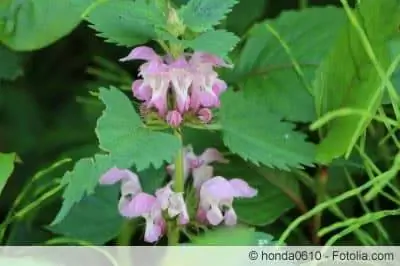
Diseases and pests
Deadnettles are actually quite robust. However, they occasionally suffer from aphid infestations and fungi also tend to spread. Gray mold is particularly common. You can recognize it by the softening of leaves and stems, the rotting and the typical gray, heavily dusty fungal turf. Here, prevention is better than cure, because the disease cannot actually be combated except by cutting away affected parts or removing the diseased plant before the disease spreads. It is therefore important to choose a suitable location, prepare the planting substrate accordingly and work regularly with plant strengthening agents.
- Grey mold - dusty coating on the plant
- Prevention is best
- Remove affected plant parts or entire plant
Aphids attack most plants. Dead nettles are no exception. Aphids suck plant sap and thus weaken the plants. They also transmit viruses. So you should do something quickly against the pests. Aphids can be recognized by curled leaves, sometimes blistered leaves and by sticky spots and spots on leaves, the planter or the soil around the plant. These are the excretions of the lice, the so-called honeydew. It is also harmful because sooty mold fungi like to settle on it and these further weaken the dead nettles. The aphids prefer to sit under the leaves or on the young shoots. The pests are quite easy to eliminate. You simply spray them with a sharp jet of water or spray them with a mixture of water, a splash of spirit and a splash of dishwashing liquid. The treatments usually have to be repeated several times.
Conclusion
Deadnettles are grateful plants. They require little care and the older they are, the less you have to care for them. However, the right location and a good planting substrate are important. If the plants are then supplied with sufficient water and nutrients, they will thrive. Insects love dead nettles, and the plants are particularly important for bees.

